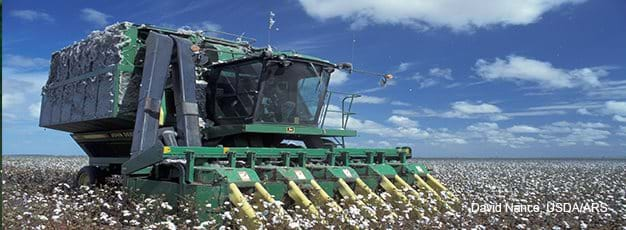A New World for U.S. Cotton Producers

As the most export-dependent U.S. program crop, cotton faces unique challenges in the 21st century. Global textile trade reform has altered patterns of world cotton consumption and trade. The proportion of U.S. cotton that is exported is now at its highest level since the 1850s. The domestic landscape is also undergoing a transformation, with U.S. cotton production increasingly concentrated on larger farms and new technology driving U.S. cotton yields higher. However, technology knows no borders, and yields in other countries are rising strongly as well, a sure sign of future competition for an export-oriented U.S. cotton sector.
With the decade-long phaseout of the Multifibre Arrangement’s (MFA) global textile quotas, high-income countries have seen a sharp drop in industrial fiber demand. The loss of import protection provided by the MFA has led to significant declines in textile production and lower demand for raw cotton in the United States, the European Union, and Japan. Now, U.S. cotton growers find their customers primarily overseas, with China by far the leading importer. But they also face new risks as trade shifts to countries with higher tariffs and other trade barriers. An ongoing World Trade Organization (WTO) dispute concerning U.S. cotton programs further highlights the risks facing the U.S. cotton sector as it transitions from domestic to export markets. Responding to a complaint brought by Brazil, the WTO determined that U.S. cotton programs had reduced world prices and that changes were necessary to bring the U.S. in line with its obligations as a WTO member.
U.S. cotton producers are likely to face increased competition in future years as technologies first adopted in the U.S.—genetically engineered (GE) cotton and other agricultural technologies—spread to other countries. India, for example, has adopted GE cotton and managed to expand its cotton area and achieve significant growth in yields. Production rose 70 percent in 5 years, and India, once one of the world’s largest importers of cotton, is now one of the largest U.S. competitors.
While technology has also significantly raised U.S. cotton yields and helped to reduce per acre costs, U.S. cotton farmers continue to look to government programs to supplement their incomes. The WTO dispute has already resulted in some program changes for cotton, and the next round of domestic farm legislation likely will be decided in the context of the resolution of the WTO dispute, Federal budgetary concerns, and continuing trade talks.
Cotton Backgrounder, USDA, Economic Research Service, March 2007
Cotton and Wool, by Leslie Meyer, Taylor Dew, and Philip Jarrell, USDA, Economic Research Service, June 2024
Forces Shaping World Cotton Consumption After the Multifiber Arrangement, Economic Research Service, April 2005, CWS-05C-01.


